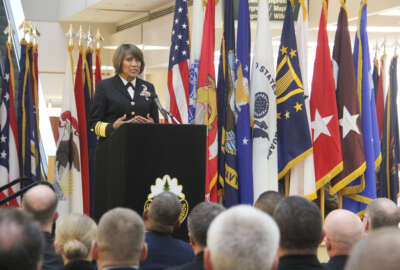
DoD’s new health record driving broader IT upgrades in military health system
DoD's adoption of a new electronic health record is a major driver for a bevy of other upgrades to health IT in the military health system, including a new,...
When the Defense Department installed its new electronic health record at four initial sites in the Pacific Northwest earlier this year, it wasn’t as simple as ripping out the old systems and firing up the new one, MHS Genesis.
To say nothing of the change in management and training involved at each site, the “go-live” dates were also preceded by months of legwork to install new back-end hardware, software and network infrastructure to support the new system — work that still must be done at more than 100 military treatment facilities around the world.
The umbrella term the Defense Health Agency is using for the upgrade initiative is “Desktop to Datacenter” (D2D). It involves moving each hospital and clinic to a new shared, purpose-built wide area network called the Medical Community of Interest (Med-COI), providing a common desktop to users across the military health system, a single security architecture, a consolidated helpdesk and transitioning numerous other locally-provided IT functions to central services provided by DHA.
“Historically, this is one of the most complex things that we’ve ever done,” Col. Kevin Seeley, DHA’s deputy chief information officer, said in an interview for Federal News Radio’s On DoD. “It’s one thing to do a merger and acquisition between two organizations, but bringing four different organizations together culturally, we have to have a solid plan for what we’re going to do at each of those sites. However, what we’ve found as we as we communicate with sites and as we get the vision out and we talk to commanders and staffs is that they understand the importance of doing what we’re doing. They understand they want to get to a new technical construct, and they’re very excited. Working through the challenges is very complex, and it is a multi-year process. It’s not something that anybody could do in a short period of time.”
Defense officials are still waiting for a milestone decision by the department’s acquisition leadership before they chart out the rest of the deployment schedule for Genesis, which is expected to be fully-deployed around the world by 2025. And the timeline for individual military treatment facilities to transition to the D2D and Med-COI environments is tightly linked to the Genesis rollout.
But it’s also being driven by a congressional directive for DHA to take over the management of military treatment facilities by October 2018. Under current law, the agency will be responsible for not just those facilities’ IT, but their day-to-day administration, budgets, construction, policies and procedures.
Based on business case analyses and zero-based budget reviews that have already been conducted, DoD has already started reducing the military health system’s budget projections starting in 2019, in anticipation that it will be able to produce savings through consolidation.
And Seeley said DHA is using the D2D and Med-COI initiatives to accomplish other DoD IT modernization priorities in parallel, such as migrating the health system’s computers to Windows 10. And moving an entire site’s workforce to the Defense Enterprise Email service is a prerequisite before any migration to D2D and Med-COI, which operates as a virtual private network also provided by DISA.
“If you look at the order of events, if you’re doing construction, building a building, you need to do certain things first,” he said. “In the case of an IT migration, it was key for us to move to email for a couple of the military services that had their own email, so instead of bridging that email gap through network boundaries, we’re able to grab that right across the Med-COI. The idea is for us not to go out and build all of this on our own. We need to leverage enterprise services that already exist, and email is a good example of that.”
Once D2D and Med-COI are fully rolled out, a clinician is supposed to be able to insert his or her credentials into any computer on the Med-COI network anywhere in the world and see the exact same desktop, have access to the same applications, and be able to view patient records that originated in a DoD facility, a Veterans Affairs facility, and even clinical encounters from private-sector providers via the network’s connections with state and local health information exchanges.
And constructing a network that can maintain that level of connectivity and interoperability while ensuring it is secure has proved to be a challenge, Seeley said.
“We have a lot of connected devices, and ‘Internet of Things’ can be can be used as a term to describe the things that are connected within the medical environment,” he said. “As we build this out, we have to take into account every detail. Every detail of what the enclave looks like and how we manage across VLANs, how we protect the rest of the network from medical devices, how we protect the information that’s being stored in our data centers. Those are all considerations as we build out the architecture for the Med-COI and D2D. The medical device piece is as critical as a challenge for the entire medical and health care industry. As more and more devices are being connected up to the network, that drives things like storage, bandwidth and ability to secure those devices.”
Copyright © 2025 Federal News Network. All rights reserved. This website is not intended for users located within the European Economic Area.
Jared Serbu is deputy editor of Federal News Network and reports on the Defense Department’s contracting, legislative, workforce and IT issues.
Follow @jserbuWFED
Related Stories





